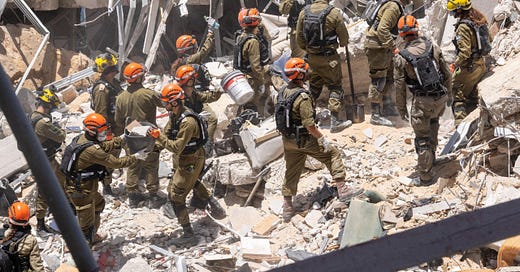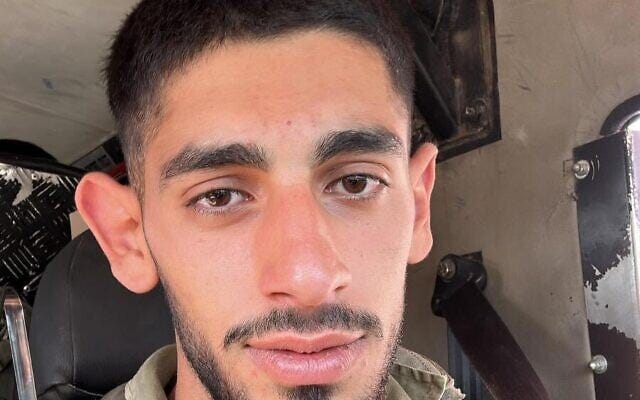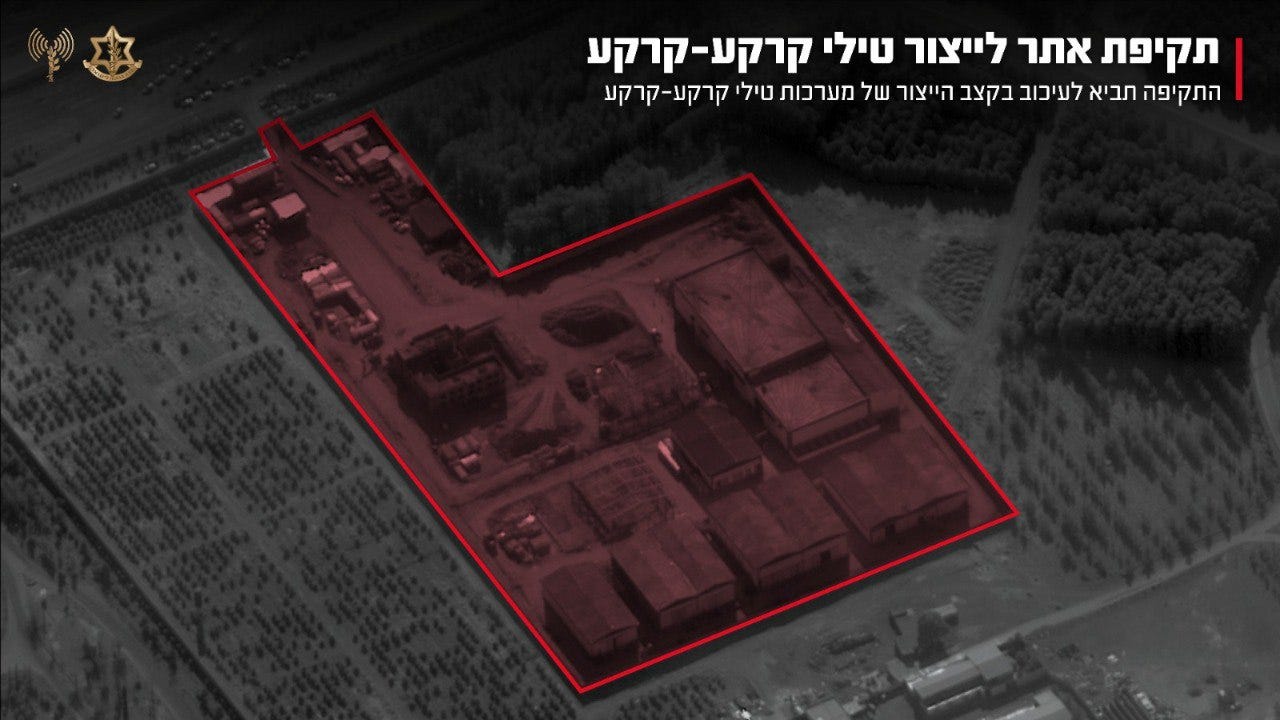DAY 3 OF THE IRAN WAR • DAY 618 OF THE WAR: Soldier Killed in Gaza; Israeli Strikes on Tehran Intensify; Missile Attacks Kill More Than 11 in Israel; What Prompted Israel to Strike Now?
Tel Aviv Diary, June 15, 2025
Despite the fact that all eyes are on our war with Iran, I want to begin today’s update with Gaza. We cannot forget Gaza, the hostages still being held there, and the ongoing fighting. The Gaza front claimed another life over Shabbat: Sgt. First Class (res.) Noam Shemesh (21), from Jerusalem, who served as a squad commander in the Kfir Brigade’s Shimshon Battalion.
While our close attention has shifted from what’s happening in Gaza, our soldiers continue to fight, and our hostages are still suffering. At the same time, reports of problems with food distribution in Gaza have led to additional Palestinian casualties.
ISRAEL CONTINUES ITS IRAN OFFENSIVE
Israel continued its offensive operations against the Iranian regime today, striking a series of strategic targets overnight. According to Israeli military sources, the IDF hit the headquarters of the Islamic Revolutionary Guard Corps (IRGC), the Atomic Energy Commission, the Iranian Army’s military command, and a major oil storage facility that sent flames and thick smoke into the night sky.
The campaign resumed with additional strikes on government infrastructure, including the Ministry of Justice and the IRGC’s Intelligence Division. Media outlets report the deaths of 14 Iranian scientists—five of whom it appears were killed in car bombings. The nature of those attacks suggests they were carried out locally rather than by Israeli airstrike.
Prime Minister Netanyahu confirmed that an Israeli airstrike earlier this afternoon eliminated the general staff of the Revolutionary Guard’s intelligence bureau. Israel’s complete control of the airspace above both Western Iran and the strategic corridor leading to Tehran has provided the Israeli Air Force operational capabilities previously only imagined.
After the Yom Kippur War, I recall reading an account of Israeli pilots being dispatched to bomb the Syrian defense headquarters—located just 50 or 60 miles from our border in Damascus. To avoid the dense anti-aircraft systems surrounding the Syrian capital, they were forced to fly at treetop level, navigating through valleys to evade detection and carry out their mission.
Now, following Israel’s unprecedented dismantling of Iran’s overall air defense network, the flight from Israeli airbases to Tehran has become a direct, two-hour operation. While pilots must remain vigilant—aware that a concealed anti-aircraft system may have been overlooked and could require evasive action—IAF pilots can now focus on reaching and destroying their targets. This is an astonishing shift in Israel’s operational reach. It was once assumed that Israel could only launch a few raids per week against Iranian targets. These missions are now being carried out every day, around the clock.
This afternoon, Israeli forces successfully struck a tanker aircraft at Mashhad Airport in northeastern Iran—the most distant target hit so far in this conflict, located some 2,300 kilometers from Israel’s borders.
THE IRAN CAMPAIGN: CAN ISRAEL GO IT ALONE?
The entire discussion around why Israel once viewed United States intervention in Iran as essential has largely centered on Israel’s limited ability to project sustained prolonged military pressure deep inside Iranian territory. Unlike the U.S.—with its aircraft carriers and nearby bases that enable continuous operations—Israel has long faced significant logistical challenges in projecting sustained force at such distances. There is ongoing debate over whether the U.S. will become involved in Israel’s current campaign in Iran, and more critically, what steps Israel might take to persuade the U.S. to do so.
In my view, involving the U.S. in the offensive dimension of this war would be a strategic misstep. While American participation could ease certain operational challenges—particularly when it comes to heavily fortified sites like Iran’s Fordow nuclear facility, buried deep under a mountain—difficult to penetrate without the massive bunker-busting munitions that only the U.S. possesses—I believe the Israeli Air Force has developed its own solution for neutralizing that target.
Involving the U.S. into Israel’s Iranian campaign introduces significant complications: ranging from increased coordination requirements, disputes over targeting, and the political baggage of becoming entangled in America’s internal disputes. Figures like Tucker Carlson have already begun criticizing President Trump for supporting Israel’s right to defend itself. In my view, Carlson is both antisemitic and anti-Israel.
It was reassuring, however, to hear President Trump respond firmly, saying, “What do you mean MAGA is against this? I started MAGA, and I decide what is good for MAGA. And if you want peace in the world, there can’t be peace if Iran has a nuclear bomb.”
That said, in my opinion, it remains in Israel’s best interest to continue its operations independently. While it may take slightly longer, if the United States provides the time and diplomatic space for Israel to act, I believe we can achieve our strategic objectives without direct American military involvement.
President Trump’s intentions regarding Iran remain somewhat unclear. This morning, Trump issued a statement calling for an end to the war, claiming that secret negotiations are underway, and that Israel and Iran will soon live in peace. It’s difficult to say what prompted such optimism.
Trump also asserted that Russian President Putin called him and offered to help mediate an end to the war. But let’s be clear: Putin is the last person Israel wants involved at the negotiating table. He is a staunch ally of Iran and heavily dependent on Iranian drones in his war against Ukraine. (Incidentally, it appears Israel may have destroyed Iran’s drone manufacturing facility just yesterday.)
TRUMP REPORTEDLY VETO’ED STRIKING IRAN’S SUPREME LEADER
This evening, reports emerged that President Trump vetoed a proposed operation to eliminate Iran’s Supreme Leader, Ayatollah Khamenei. Experts I spoke with believe the strike should have proceeded—arguing that removing Khamenei could have triggered the collapse of the regime and opened the door to meaningful change.
Eventually, this war will likely end through a negotiated settlement—unless, of course, a popular uprising erupts in Iran, a possibility that cannot be ruled out. Regimes often sustain themselves through a carefully cultivated facade of strength. But once that illusion is shattered—as now appears to be the case in Iran—the fall can come swiftly and unexpectedly.
I won’t offer predictions. I can only hope.
IRAN’S NUCLEAR SPRINT AND WHY ISRAEL STRUCK NOW…
A significant development was reported today that sheds light on the key factor prompting Israel’s decision to act at this moment. According to a highly reliable defense correspondent, shortly after October 7th, the Iranian regime issued a directive to its scientists. They were ordered to accelerate efforts to develop the technology needed to bring Iran within one week of assembling a nuclear bomb.
While the regime did not order the bomb itself to be built, it explicitly tasked its teams with removing all remaining technical obstacles—ensuring Iran could cross the nuclear threshold within just one week. It remains unclear exactly when Israeli intelligence uncovered this information, but it appears the discovery was made relatively recently. Once verified, it left Israel with little choice but to respond.
It’s important to keep in mind the sequence of events. Once Hezbollah was effectively neutralized as a major threat and could no longer hold Israel hostage with its missile arsenal, and after Israel eliminated key Russian-made anti-aircraft systems protecting much of Iran during an earlier exchange, the path was cleared for a broader military strike.
Some may question whether this narrative is credible—or simply political spin from Prime Minister Netanyahu’s government. That’s a fair concern. To assess it, I reached out to a trusted source with a long career in intelligence. He told me he believes the report is accurate. And if he believes it, I do too.
With that context— and with President Trump’s reported approval to proceed—I believe Israel had little choice regarding the timing or scope of the operation.
MISSILE ATTACKS CONTINUE
Of course, everything I’ve written so far reflects only one side of the story. The other side is Iran’s missile attacks on Israel. Last night, after I released the diary, we were alerted to an imminent Iranian strike. We headed down to the shelter beneath our building. After waiting for some time without hearing any sirens in our area, we later learned that there were no sirens, and that it was safe to leave the shelter.
Sirens did sound in the north, particularly around Haifa. Several missiles managed to breach Israel’s defense systems there. One struck the Arab town of Tamra with devastating consequences, killing four members of a single family.
Another missile hit the oil refineries near Haifa, damaging part of the pipeline that transports oil from the south to the north. From what I understand, the damage was not extensive.
After returning to our apartment, we managed to get some rest. But close to 3 a.m., another wave of Iranian missiles was reported heading our way. We joined our still-groggy neighbors in the shelter. Just minutes after we sealed the heavy metal door, a series of distant booms echoed through the night.
This time, the explosions were farther away than those the night before. One missile struck a 10-story residential building in the Tel Aviv suburb of Bat Yam, destroying an entire wing. Seven people were killed in the blast, including two children. As of now, three others remain missing. It will likely take another day to clear the rubble of the collapsed section.
During the same wave of attacks, another missile struck Rehovot, causing damage to several buildings and laboratories on the campus of the Weizmann Institute. The city’s train station was also hit.
Until now, all of the missile attacks had occurred at night. But this afternoon, we were all caught off guard by a sudden alert warning of an imminent strike. Fortunately, we were all home at the time and quickly made our way to the bomb shelter. We never heard the sound of incoming missiles, and thankfully, shortly afterward, reports confirmed that all projectiles had been intercepted before reaching Israeli territory.
As we were preparing this update tonight, another missile alert was issued at 8:37p.m. We headed back down to the shelter, and minutes later, air raid sirens began to sound. In this barrage—fewer than 30 missiles in total—one struck a synagogue in a Moshav in southern Israel, lightly wounding four people. A second missile hit a residential neighborhood in a northern city, sparking a fire that injured at least seven others.
Since the start of Israel’s operation in Iran, 13 people have been killed and over 300 injured—a toll that, regrettably, can be expected to rise.
In addition, an estimated 100,000 Israelis remain stranded abroad, with no clear path home as long as Ben Gurion Airport remains closed—a closure that, I fear, will persist for the foreseeable future.
AVIV ATZILI, z”l
Tonight, authorities released the name of a second Israeli whose remains were recovered from Gaza by the IDF last week: Aviv Atzili, a lifelong member Kibbutz Nir Oz. Aviv was part of the kibbutz's rapid response squad and was killed while defending his community during the October 7th attack. His wife, Liat Atzili, was later taken hostage by Hamas and held captive in Gaza for 54 days before being released.
Aviv is survived by his wife, Liat, and their three children—Ofri, Netta, and Aya. Liat, an American citizen, is the daughter of two Americans who immigrated to Israel in 1973 with a Hashomer Hatzair garin and helped establish Kibbutz Shomrat
.








